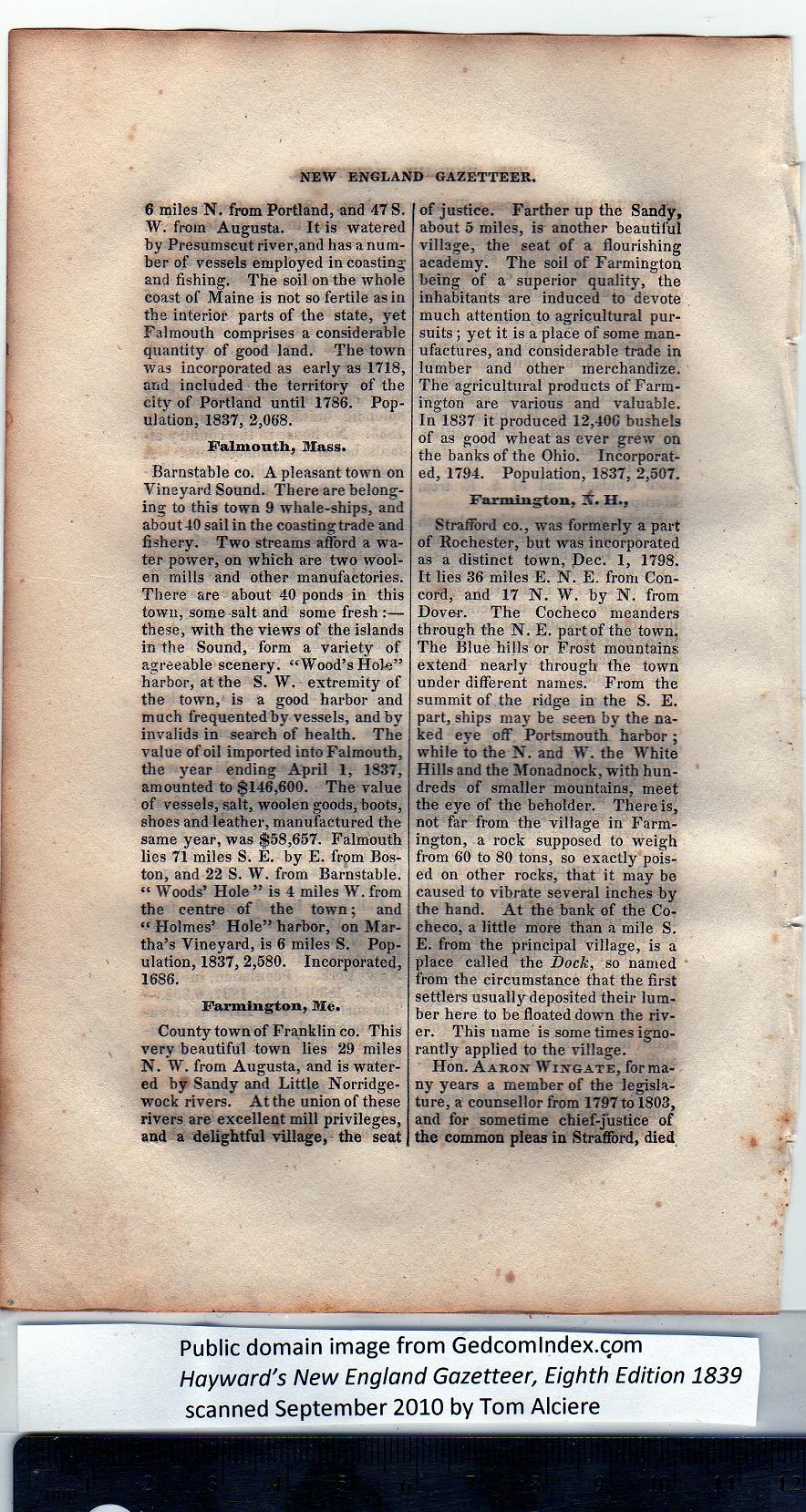|
6 miles N. from Portland, and 47 S.
W. from Augusta. It is watered
by Presumscut river,and has a num-
ber of vessels employed in coasting
and fishing. The soil on the whole
coast of Maine is not so fertile as in
the interior parts of the state, yet
Falmouth comprises a considerable
quantity of good land. The town
was incorporated as early as 1718,
and included the territory of the
city of Portland until 1786. Pop-
ulation, 1837, 2,068.
Falmouth, Mass.
Barnstable co. A pleasant town on
Vineyard Sound. There are belong-
ing to this town 9 whale-ships, and
about 40 sail in the coasting trade and
fishery. Two streams afford a wa-
ter power, on which are two wool-
en mills and other manufactories.
There are about 40 ponds in this
town, some salt and some fresh :—
these, with the views of the islands
in the Sound, form a variety of
agreeable scenery. “Wood’s Hole”
harbor, at the S. W. extremity of
the town, is a good harbor and
much frequented by vessels, and by
invalids in search of health. The
value of oil imported into Falmouth,
the year ending April 1, 1837,
amounted to 0146,600. The value
of vessels, salt, woolen goods, boots,
shoes and leather, manufactured the
same year, was 058,657. Falmouth
lies 71 miles S. E. by E. from Bos-
ton, and 22 S. W. from Barnstable.
“ Woods’ Hole ” is 4 miles W. from
the centre of the town; and
“ Holmes’ Hole” harbor, on Mar-
tha’s Vineyard, is 6 miles S. Pop-
ulation, 1837,2,580. Incorporated,
1686.
Farmington, Me. |
County town of Franklin co. This
very beautiful town lies 29 miles
N. W. from Augusta, and is water-
ed by Sandy and Little Norridge-
wock rivers. At the union of these
rivers are excellent mill privileges,
and a delightful village, the seat
of justice. Farther up the Sandy,
about 5 miles, is another beautiful
village, the seat of a flourishing
academy. The soil of Farmington
being of a superior quality, the
inhabitants are induced to devote
much attention to agricultural pur-
suits ; yet it is a place of some man-
ufactures, and considerable trade in
lumber and other merchandize.
The agricultural products of Farm-
ington are various and valuable.
In 1837 it produced 12,406 bushels
of as good wheat as ever grew on
the banks of the Ohio. Incorporat-
ed, 1794. Population, 1837, 2,507.
Farmington, I. H.,
Strafford co., was formerly a part
of Rochester, but was incorporated
as a distinct town, Dec. 1, 1798.
It lies 36 miles E. N. E. from Con-
cord, and 17 N. W. by N. from
Dover. The Cocheco meanders
through the N. E. part of the town,
The Blue hills or Frost mountains
extend nearly through the town
under different names. From the
summit of the ridge in the S. E.
part, ships may be seen by the na-
ked eye off Portsmouth harbor;
while to the N. and W. the White
Hills and the Monadnock, with hun-
dreds of smaller mountains, meet
the eye of the beholder. There is,
not far from the village in Farm-
ington, a rock supposed to weigh
from 60 to 80 tons, so exactly pois-
ed on other rocks, that it may be
caused to vibrate several inches by
the hand. At the bank of the Co-
checo, a little more than a mile S.
E. from the principal village, is a
place called the Dock, so named
from the circumstance that the first
settlers usually deposited their lum-
ber here to be floated down the riv-
er. This uame is some times igno-
rantly applied to the village.
Hon. Aaron Wingate, for ma-
ny years a member of the legisla-
ture, a counsellor from 1797 to 1803,
and for sometime chief-justice of
the common pleas in Strafford, died |
